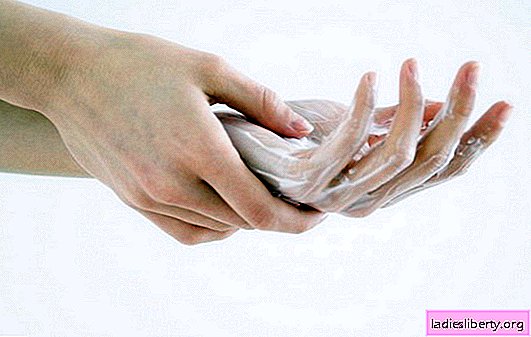
Due to the accelerated rejection of dead epidermal tissues on the hands, peeling of the skin occurs.
This problem is familiar to all people without exception, because there are a lot of factors that provoke peeling.
But what is the physiological norm, and in which cases of peeling, you need to go to the doctor?
We can definitely say that the constant peeling of the skin on the hands needs to be corrected by cosmetic or medical methods.
Let's look at the causes of peeling and learn how to improve the condition of the skin on the hands.
Peeling of the skin on the hands: causes
The skin on the hands begins to peel off when there is increased rejection of cells of the upper stratum corneum of the epidermis. Updating the epidermis is vital, dead cells are constantly separated from the skin, due to which its elasticity and softness are maintained. But this process is normally invisible to us, since particles of dead skin are removed every day while washing or wiping hands. When the process becomes noticeable, the pieces of skin are separated by scales, talking about pathological peeling of the skin on the hands.
The problem is caused by two factors:
• parakeratosis (the formation of initially defective cells of the stratum corneum);
• hyperkeratosis (accelerated formation of stratum corneum cells);
• environmental impact.
By external action on the skin is meant:
• dry air;
• frostbite;
• weathering;
• moisture loss;
• exposure to aggressive substances (including salt water);
• mechanical damage (scratches, wounds);
• allergic reaction.
Easy frequent peeling of the skin on the hands is a variant of the norm for people with constantly wet hands, as well as with a lack of nutrients, vitamins and minerals in the diet (most often vitamin A and PP).
Peeling due to external factors (contact dermatitis) passes independently and quickly enough after eliminating this effect. As for pathologies in the formation of skin integuments, the situation here is somewhat more complicated.
Ichthyosis
A genetic disease that first appears at two to three years of age. Hyperkeratosis with ichthyosis leads to severe flaking of the skin on the arms and trunk. The skin thickens and thickens, leading to cracks, and mucous flakes form.
Psoriasis
Autoimmune, non-communicable disease. With psoriasis, most often on the arms and legs, pink and red spots are formed, covered with yellowish scales. These foci may be the only manifestation of the disease, but bring a lot of problems to the patient, as they often cover most of the palms or soles.
Acquired Zinc Deficiency
The tips of the fingers are most prone to peeling and cracking, but whole hands, feet, elbow and popliteal fossae also come under attack. Intense rejection of the upper layer of the epidermis is accompanied by redness and itching, leading to the formation of blisters, and then erosion. The cracks are deep, while the psychological state of the patient changes - irritability and depression appear.
Atopic dermatitis
Thickening, redness and peeling of the skin on the arms and legs, covering with whitish scales are characteristic. The nature of atopic dermatitis is a hereditary predisposition to allergic reactions. The disease often develops before the age of 1 year, and persists to a greater or lesser extent throughout life, with stages of remissions and exacerbations.
Dyshidrosis
It is localized on the skin of the hands and feet. It appears in the form of dropsy between the fingers, which, over time, begin to peel and itch. The causes of this phenomenon are still unknown, it is believed that it arises from a combination of several factors. The treatment is antihistamine and symptomatic, possibly a diet.
Pityriasis versicolor
The causes of peeling of the skin on the hands with pityriasis versicolor are an increase in the number of conditionally pathogenic yeast fungus Malassezia and an increase in its vital activity. In this case, the formation of clearly defined small spots of irregular shape on the arms and upper body, as well as in the groin and genitals, is characteristic. Its treatment is complex and complex, only under the supervision of a doctor.
Allergic dermatitis
The nature and development of the disease is clear from the name. Peeling, itching and cracks in the hands with severe redness can concentrate not only at the site of exposure to the allergen, but also spread further through the body.
Lichen planus
Disease of an indeterminate nature - suggest an autoimmune, viral or toxic origin. Plaques appear on the arms and legs, which at first peel off only in the center, but as the disease develops, the skin is covered over the entire surface of the rashes, which acquire a purple hue.
Eczema
Infectious and allergic disease against the background of a genetic predisposition. It leads to large red spots, often on the back of the hands (appears on the feet). The impetus for the development of the disease is often infection and stress.
Scarlet fever
In addition to fever and fever, this infectious disease on day 4-5 causes intense flaking of the skin. Small branched scales appear on the body, and large pieces of the epidermis exfoliate from the soles and arms (especially the fingertips).
Secondary syphilis
A very unpleasant state of secondary syphilis is accompanied by flaky spots on the palms of the hands. At first, the spots have a pink hue, then turn into copper, and shortly before the disappearance, they become bright, red-blue.
Scabies
The itch mite most often penetrates the thin skin of the hands between the fingers. Hands are covered with "nodules" - flaky red spots, slightly above the main skin. There are frequent cases of purulent infection through itchy spots.
Other infectious diseases
A viral, bacterial or fungal infection leads to the rapid multiplication (often hidden in the initial stages) of pathogenic microorganisms, the skin abruptly begins to peel off, often itching. With such symptoms, self-medication is ineffective.
Peeling of the skin on the hands: methods of treatment
How to treat scarlet fever
Very quickly increases the surface of damaged skin with ultraviolet radiation. In this regard, the patient is contraindicated in sunlight, a solarium and other sources of ultraviolet radiation. Peeling of the skin on the hands disappears faster if you lubricate your hands with special ointments (Ryabova, Lyassar paste), which stimulate the discharge of crusts from the lesion. Be sure to apply dressings on this skin and minimize the effects of water and aggressive substances.
Doctors prescribe a complex antiviral, antibacterial, antifungal and immunomodulating treatment for scarlet fever. You will also need diuretics. Self-medication with scarlet fever is unacceptable!
Peeling of the skin with psoriasis
Unfortunately, it is not yet possible to completely cure the disease, but there is a chance to remove the symptoms for a long time. Here, one can not do without medical assistance, since only a specialist can choose from the currently available 700 methods of treatment suitable in a particular case.
Fungal infections
Unfortunately, no matter what folk healers say, it is impossible to cure the fungus with their means. Only antiseptics and antifungal drugs in the complex can get rid of the fungus. In all other cases, the disease will progress, and it will be increasingly difficult to respond to treatment.
Doctors often prescribe clotrimazole for the fungus, as the most effective antifungal drug, as well as aniline dyes, boric acid, aqueous solutions of silver nitrate, rivanol and resorcinol.
Unfortunately, peeling of the skin on the hands caused by certain diseases sometimes requires inpatient treatment, not to mention urgent drug therapy. Do not postpone a visit to the doctor if dry reddened skin with peeling and itching bothers you throughout the day.
Peeling of the skin on the hands: folk remedies
You can remove the symptoms of peeling hands using one of the proven folk remedies:
• Grease hands with a fat cream. Dissolve 50 grams of baking soda in a liter of warm water and immerse your hands in this solution for a quarter of an hour. Massage your hands and grease again with plenty of cream.
• Baths based on vegetable oils. Olive oil is considered the best from peeling the skin on the hands, but sunflower oil is also suitable. The procedure is done before bedtime. Immerse your hands in oil heated to a pleasant temperature for 15 minutes, wipe and put on soft gloves at night. After a couple of procedures, the skin of the hands will become soft and moisturized.
• Flaxseed also improves skin condition. Pour a glass of water into the dishes, pour two tablespoons of flax seed and boil until thick. Lubricate the skin of the resulting broth.
• Dry skin on the hands can be removed with a carrot mask. To prepare it, grate the carrots on a fine grater, pour in two tablespoons of milk and pour a spoonful of ground oatmeal. Apply a thoroughly mixed mass to the skin for 20 minutes. Rinse and grease with olive oil.
Peeling of the skin on the hands: prevention
The main preventive measures from peeling the skin on the hands are:
• proper nutrition;
• regular hand washing in warm water using gentle means;
• thorough drying of hands before going outside (pay special attention to the interdigital space);
• in winter, regularly and thoroughly grease your hands with oily cream, it’s good to use olive oil at night, do not go outside without gloves or mittens;
• exfoliate dead skin cells of the hands with scrubs;
• wear gloves before using aggressive substances;
• before going to bed, massage the hands, starting from the tips of the fingers and nails, right up to the base of the hand.











